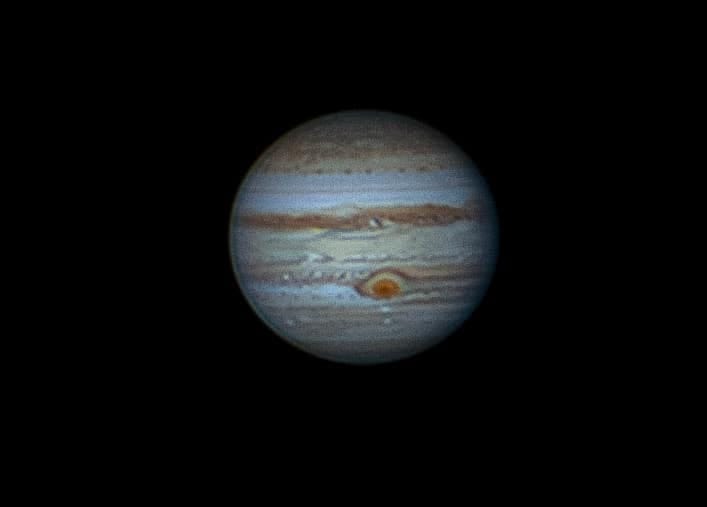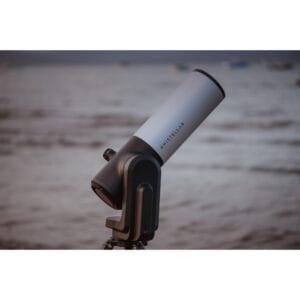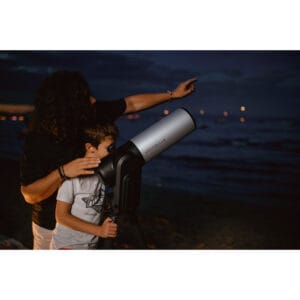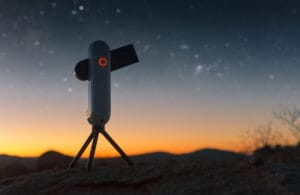Seeing Jupiter through a telescope is the moment when stargazing comes alive for many people. But what does the gas giant really look like through your telescope? What’s possible with post-processing? And what magnification do you need to see Jupiter well? In this blog, we provide clear answers, supported by real images from realistic observations to stacked astrophotos.

What Do You See when Viewing Jupiter Live?
Without tricks or processing, you see Jupiter as a bright disk with one or two brown bands. These are gigantic storm belts stretching across the planet. Even with a simple 76 mm Dobsonian and magnification around 100x, these bands become visible, along with the four largest moons: Io, Europa, Ganymede, and Callisto. These appear as small points of light in a straight line around the planet.

The first and second images in this blog show such a visually realistic view. It’s what you can expect with a decent telescope without digital post-processing. The colors are subtle, the details limited, but the feeling that you’re really looking at another world remains magical.
How Does Jupiter Look with Post-Processing?


The sharper, higher-contrast photos in this blog were made using multiple techniques:
- High frame rate video recordings
- Image selection and stacking (for example in AutoStakkert or Pixinsight)
- Color correction and sharpening
Examples of this are these images: Jupiter shows multicolored cloud bands, a clear Great Red Spot, and even shadows of moons on the planet’s surface. You achieve this level with:
- A telescope with 150-200 mm aperture
- A camera like the ZWO ASI series or a smartphone + adapter
- Patience, software and good seeing (that is, good atmospheric conditions… which means not just clear skies, but also “clean” air!)
The result is impressive, but not what you see directly with the naked eye through an eyepiece. Still, it’s incredible that you’re looking at another world, millions of kilometers above us.
At What Magnification Can You See Jupiter Well?
For a usable, detailed view of Jupiter, the following applies:
- Minimum magnification: 60x (disk and moons visible)
- Ideal magnification: 100x-150x
- Maximum usable magnification: 2x aperture in mm
A telescope with 76 mm aperture thus offers maximum 150x magnification, which is just enough to see Jupiter well. With larger telescopes (150 mm or more), you can go up to 250x-300x, allowing finer details if atmospheric conditions permit.
Note: more magnification without sufficient aperture results in a dark and blurry image. A good combination of optical quality, stable mounting, and the right magnification is essential.
What’s the Best Time to Observe Jupiter through a Telescope?
The best period is during opposition, which is when Jupiter is directly opposite the sun and thus closest to Earth. The next opposition is on November 6, 2025, a perfect time to set up your telescope.
Additionally:
- Observe when Jupiter is high in the sky (around midnight, but not a strict requirement. This is only for the best “seeing”).
- New moon (so no full moon/little moonlight)
- Let your telescope acclimate to the outdoor temperature
Extra tip: Light pollution matters little for planets. This is because planets are relatively bright and close to Earth. Their light is barely hindered by city lighting, unlike faint deep-sky objects such as nebulae or galaxies.
What Can You Improve with Filters?
For visual observations and photography, color filters are valuable:
✓ #82A light blue: enhances contrast in cloud bands
✓ #58 green: makes the Great Red Spot more visible
✓ Methane filter (CH4): for advanced photographers, shows deep structures in the atmosphere
Note: filters help mostly with larger telescopes with high light gathering power. View our collection of filters here.
See also this NASA page about Jupiter for more scientific background.
Which Telescope is Suitable for Jupiter?
Recommendations for realistic and detailed viewing are:
- GSO Dobson 152/1200: excellent value for money, visually powerful
- GSO Dobson 200/1200 Deluxe: more aperture = more details for planets
- Celestron StarSense Explorer 130 mm: for those who want help finding Jupiter
- Sky-Watcher Heritage collection: sharp image at lower magnifications
The selection guide for planetary observations on telescoop.nl helps you make the right choice.
What Can You See with a 76 Mm Telescope?
A frequently asked question: is a small telescope like the Celestron FirstScope or a 76 mm Dobson sufficient? Answer: yes, for a first introduction. Expect:
✓ Sharp image of Jupiter as a disk
✓ Two cloud bands at 100x magnification
✓ The four major moons
✗ No fine details or colors
✗ No Red Spot unless under exceptionally good conditions
Perfect as a starting point, or as a gift for your child… but those who want to look deeper should choose a telescope with at least 130-150 mm aperture.
Conclusion
Seeing Jupiter through a telescope isn’t a static moment. The moons change position, the bands shift, and on good nights even the Great Red Spot appears. The images in this blog show the difference between what you see with your own eyes and what astrophotographers achieve with technique and patience.
Ready to start?
Check out our range of suitable telescopes. Discover for yourself how impressive Jupiter really looks, live, in your backyard or in a field.




